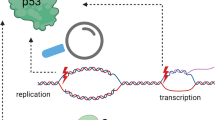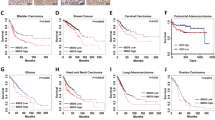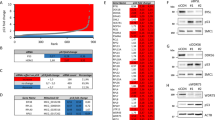Abstract
Ribosomal proteins have emerged as novel regulators of the Mdm2-p53 feedback loop, especially in the context of ribosomal stress. RPS26 is a recently identified Diamond-Blackfan Anemia-related ribosomal protein and its role in p53 activation has not been previously explored. In this study we found knockdown of RPS26 induced p53 stabilization and activation via a RPL11-dependent mechanism, resulting in p53-dependent cell growth inhibition. Moreover, RPS26 has the ability to interact with Mdm2 and inhibits Mdm2-mediated p53 ubiquitination that leads to p53 stabilization upon overexpression. Importantly, we discovered that RPS26 knockdown impaired p53’s ability to transcriptionally activate its target genes in response to DNA damage, without affecting its stability. Accordingly, the cells lost the ability to induce G2/M cell cycle arrest. We further found that upon RPS26 knockdown, the DNA damage induced recruitment of p53 to the promoters of its target genes and p53 acetylation were both greatly reduced. In addition, RPS26 can interact with p53 independent of Mdm2 and coexist in a complex with p53 and p300. These data establish a role of RPS26 in DNA damage response by directly influencing p53 transcriptional activity, and suggest that RPS26 acts distinctively in different scenarios of p53 activation. Our finding also implicates p53 transcriptional activity control as an important mechanism of p53 regulation by ribosomal proteins.
This is a preview of subscription content, access via your institution
Access options
Subscribe to this journal
Receive 50 print issues and online access
$259.00 per year
only $5.18 per issue
Buy this article
- Purchase on Springer Link
- Instant access to full article PDF
Prices may be subject to local taxes which are calculated during checkout








Similar content being viewed by others
References
Vousden KH . Activation of the p53 tumor suppressor protein. Biochim Biophys Acta 2002; 1602: 47–59.
Vogelstein B, Lane D, Levine AJ . Surfing the p53 network. Nature 2000; 408: 307–310.
Levine AJ . p53, the cellular gatekeeper for growth and division. Cell 1997; 88: 323–331.
Vousden KH, Prives C . Blinded by the light: the growing complexity of p53. Cell 2009; 137: 413–431.
Haupt Y, Maya R, Kazaz A, Oren M . Mdm2 promotes the rapid degradation of p53. Nature 1997; 387: 296–299.
Kubbutat MH, Jones SN, Vousden KH . Regulation of p53 stability by Mdm2. Nature 1997; 387: 299–303.
Shieh SY, Ikeda M, Taya Y, Prives C . DNA damage-induced phosphorylation of p53 alleviates inhibition by MDM2. Cell 1997; 91: 325–334.
Chehab NH, Malikzay A, Stavridi ES, Halazonetis TD . Phosphorylation of Ser-20 mediates stabilization of human p53 in response to DNA damage. Proc Natl Acad Sci USA 1999; 96: 13777–13782.
Maya R, Balass M, Kim ST, Shkedy D, Leal JF, Shifman O et al. ATM-dependent phosphorylation of Mdm2 on serine 395: role in p53 activation by DNA damage. Genes Dev 2001; 15: 1067–1077.
Teufel DP, Bycroft M, Fersht AR . Regulation by phosphorylation of the relative affinities of the N-terminal transactivation domains of p53 for p300 domains and Mdm2. Oncogene 2009; 28: 2112–2118.
Kruse JP, Gu W . Modes of p53 regulation. Cell 2009; 137: 609–622.
Tang Y, Zhao W, Chen Y, Zhao Y, Gu W . Acetylation is indispensable for p53 activation. Cell 2008; 133: 612–626.
Gu B, Zhu WG . Surf the post-translational modification network of p53 regulation. Int J Biol Sci 2012; 8: 672–684.
Zhang Y, Lu H . Signaling to p53: ribosomal proteins find their way. Cancer Cell 2009; 16: 369–377.
Boulon S, Westman BJ, Hutten S, Boisvert FM, Lamond AI . The nucleolus under stress. Mol Cell 2010; 40: 216–227.
Deisenroth C, Zhang Y . Ribosome biogenesis surveillance: probing the ribosomal protein-Mdm2-p53 pathway. Oncogene 2010; 29: 4253–4260.
Dai MS, Lu H . Inhibition of MDM2-mediated p53 ubiquitination and degradation by ribosomal protein L5. J Biol Chem 2004; 279: 44475–44482.
Marechal V, Elenbaas B, Piette J, Nicolas JC, Levine AJ . The ribosomal L5 protein is associated with mdm-2 and mdm-2-p53 complexes. Mol Cell Biol 1994; 14: 7414–7420.
Zhang Y, Wolf GW, Bhat K, Jin A, Allio T, Burkhart WA et al. Ribosomal protein L11 negatively regulates oncoprotein MDM2 and mediates a p53-dependent ribosomal-stress checkpoint pathway. Mol Cell Biol 2003; 23: 8902–8912.
Lohrum MA, Ludwig RL, Kubbutat MH, Hanlon M, Vousden KH . Regulation of HDM2 activity by the ribosomal protein L11. Cancer Cell 2003; 3: 577–587.
Jin A, Itahana K, O'Keefe K, Zhang Y . Inhibition of HDM2 and activation of p53 by ribosomal protein L23. Mol Cell Biol 2004; 24: 7669–7680.
Dai MS, Zeng SX, Jin Y, Sun XX, David L, Lu H . Ribosomal protein L23 activates p53 by inhibiting MDM2 function in response to ribosomal perturbation but not to translation inhibition. Mol Cell Biol 2004; 24: 7654–7668.
Zhang Y, Wang J, Yuan Y, Zhang W, Guan W, Wu Z et al. Negative regulation of HDM2 to attenuate p53 degradation by ribosomal protein L26. Nucleic Acids Res 2010; 38: 6544–6554.
Chen D, Zhang Z, Li M, Wang W, Li Y, Rayburn ER et al. Ribosomal protein S7 as a novel modulator of p53-MDM2 interaction: binding to MDM2, stabilization of p53 protein, and activation of p53 function. Oncogene 2007; 26: 5029–5037.
Zhu Y, Poyurovsky MV, Li Y, Biderman L, Stahl J, Jacq X et al. Ribosomal protein S7 is both a regulator and a substrate of MDM2. Mol Cell 2009; 35: 316–326.
Xiong X, Zhao Y, He H, Sun Y . Ribosomal protein S27-like and S27 interplay with p53-MDM2 axis as a target, a substrate and a regulator. Oncogene 2011; 30: 1798–1811.
Sun XX, DeVine T, Challagundla KB, Dai MS . Interplay between ribosomal protein S27a and MDM2 protein in p53 activation in response to ribosomal stress. J Biol Chem 2011; 286: 22730–22741.
Zhou X, Hao Q, Liao J, Zhang Q, Lu H . Ribosomal protein S14 unties the MDM2-p53 loop upon ribosomal stress. Oncogene 2012; 32: 388–396.
Zhang X, Wang W, Wang H, Wang M-H, Xu W, Zhang R . Identification of ribosomal protein S25 (RPS25)–MDM2–p53 regulatory feedback loop. Oncogene 2013; 32: 2782–2791.
Sun XX, Wang YG, Xirodimas DP, Dai MS . Perturbation of 60 S ribosomal biogenesis results in ribosomal protein L5- and L11-dependent p53 activation. J Biol Chem 2010; 285: 25812–25821.
Llanos S, Serrano M . Depletion of ribosomal protein L37 occurs in response to DNA damage and activates p53 through the L11/MDM2 pathway. Cell Cycle 2010; 9: 4005–4012.
Fumagalli S, Di Cara A, Neb-Gulati A, Natt F, Schwemberger S, Hall J et al. Absence of nucleolar disruption after impairment of 40S ribosome biogenesis reveals an rpL11-translation-dependent mechanism of p53 induction. Nat Cell Biol 2009; 11: 501–508.
Takagi M, Absalon MJ, McLure KG, Kastan MB . Regulation of p53 translation and induction after DNA damage by ribosomal protein L26 and nucleolin. Cell 2005; 123: 49–63.
Ofir-Rosenfeld Y, Boggs K, Michael D, Kastan MB, Oren M . Mdm2 regulates p53 mRNA translation through inhibitory interactions with ribosomal protein L26. Mol Cell 2008; 32: 180–189.
Chen J, Guo K, Kastan MB . Interactions of nucleolin and ribosomal protein L26 (RPL26) in translational control of human p53 mRNA. J Biol Chem 2012; 287: 16467–16476.
Cmejla R, Cmejlova J, Handrkova H, Petrak J, Petrtylova K, Mihal V et al. Identification of mutations in the ribosomal protein L5 (RPL5) and ribosomal protein L11 (RPL11) genes in Czech patients with Diamond-Blackfan anemia. Hum Mutat 2009; 30: 321–327.
Gazda HT, Sheen MR, Vlachos A, Choesmel V, O'Donohue MF, Schneider H et al. Ribosomal protein L5 and L11 mutations are associated with cleft palate and abnormal thumbs in Diamond-Blackfan anemia patients. Am J Hum Genet 2008; 83: 769–780.
Gazda HT, Preti M, Sheen MR, O’Donohue MF, Vlachos A, Davies SM et al. Frameshift mutation in p53 regulator RPL26 is associated with multiple physical abnormalities and a specific pre-ribosomal RNA processing defect in diamond-blackfan anemia. Hum Mutat 2012; 33: 1037–1044.
Doherty L, Sheen MR, Vlachos A, Choesmel V, O’Donohue MF, Clinton C et al. Ribosomal protein genes RPS10 and RPS26 are commonly mutated in Diamond-Blackfan anemia. Am J Hum Genet 2010; 86: 222–228.
Fumagalli S, Ivanenkov VV, Teng T, Thomas G . Suprainduction of p53 by disruption of40S and 60S ribosome biogenesis leads to the activation of a novel G2/M checkpoint. Genes Dev 2012; 26: 1028–1040.
Bhat KP, Itahana K, Jin A, Zhang Y . Essential role of ribosomal protein L11 in mediating growth inhibition-induced p53 activation. EMBO J 2004; 23: 2402–2412.
Horn HF, Vousden KH . Cooperation between the ribosomal proteins L5 and L11 in the p53 pathway. Oncogene 2008; 27: 5774–5784.
Sun XX, Dai MS, Lu H . Mycophenolic acid activation of p53 requires ribosomal proteins L5 and L11. J Biol Chem 2008; 283: 12387–12392.
Dai MS, Shi D, Jin Y, Sun XX, Zhang Y, Grossman SR et al. Regulation of the MDM2-p53 pathway by ribosomal protein L11 involves a post-ubiquitination mechanism. J Biol Chem 2006; 281: 24304–24313.
Sun XX, Dai MS, Lu H . 5-fluorouracil activation of p53 involves an MDM2-ribosomal protein interaction. J Biol Chem 2007; 282: 8052–8059.
Brooks CL, W Gu . Ubiquitination phosphorylation and acetylation: the molecular basis for p53 regulation. Curr Opin Cell Biol 2003; 15: 164–171.
Tibbetts RS, Brumbaugh KM, Williams JM, Sarkaria JN, Cliby WA, Shieh SY et al. A role for ATR in the DNA damage-induced phosphorylation of p53. Genes Dev 1999; 13: 152–157.
Banin S, Moyal L, Shieh S, Taya Y, Anderson CW, Chessa L et al. Enhanced phosphorylation of p53 by ATM in response to DNA damage. Science 1998; 281: 1674–1677.
Ivanov AV, Malygin AA, Karpova GG . Human ribosomal protein S26 suppresses the splicing of its pre-mRNA. Biochim Biophys Acta 2005; 1727: 134–140.
Sundqvist A, Liu G, Mirsaliotis A, Xirodimas DP . Regulation of nucleolar signalling to p53 through NEDDylation of L11. EMBO Rep 2009; 10: 1132–1139.
Li L, Cui D, Zheng SJ, Lou H, Tang J . Regulation of Actinomycin D induced upregulation of Mdm2 in H1299 cells. DNA Repair (Amst) 2012; 11: 112–119.
Lam YW, Lamond AI, Mann M, Andersen JS . Analysis of nucleolar protein dynamics reveals the nuclear degradation of ribosomal proteins. Curr Biol 2007; 17: 749–760.
Wan F, Anderson DE, Barnitz RA, Snow A, Bidere N, Zheng L et al. Ribosomal protein S3: a KH domain subunit in NF-kappaB complexes that mediates selective gene regulation. Cell 2007; 131: 927–939.
Dai MS, Arnold H, Sun XX, Sears R, Lu H . Inhibition of c-Myc activity by ribosomal protein L11. EMBO J 2007; 26: 3332–3345.
Wanzel M, Russ AC, Kleine-Kohlbrecher D, Colombo E, Pelicci PG, Eilers M . A ribosomal protein L23-nucleophosmin circuit coordinates Mizl function with cell growth. Nat Cell Biol 2008; 10: 1051–1061.
Kuroda T, Murayama A, Katagiri N, Ohta YM, Fujita E, Masumoto H et al. RNA content in the nucleolus alters p53 acetylation via MYBBP1A. EMBO J 2011; 30: 1054–1066.
Mahata B, Sundqvist A, Xirodimas DP . Recruitment of RPL11 at promoter sites of p53-regulated genes upon nucleolar stress through NEDD8 and in an Mdm2-dependent manner. Oncogene 2012; 31: 3060–3071.
Rubbi CP, Milner J . Disruption of the nucleolus mediates stabilization of p53 in response to DNA damage and other stresses. EMBO J 2003; 22: 6068–6077.
Tang J, Qu LK, Zhang J, Wang W, Michaelson JS, Degenhardt YY et al. Critical role for Daxx in regulating Mdm2. Nat Cell Biol 2006; 8: 855–862.
Scacheri PC, Rozenblatt-Rosen O, Caplen NJ, Wolfsberg TG, Umayam L, Lee JC et al. Short interfering RNAs can induce unexpected and divergent changes in the levels of untargeted proteins in mammalian cells. Proc Natl Acad Sci USA 2004; 101: 1892–1897.
Acknowledgements
We thank Dr Xiaolu Yang for generously providing constructs and reagents; Dr Weiguo Zhu for providing the Ha-p300 expression plasmid; Yongqiang Wang for technical assistance; Dr Julia Hill for critically reading the manuscript and Caroline Kitzmiller for proofreading the manuscript. This work was supported by the National Natural Science Foundation of China (31171331); the Program for New Century Excellent Talents in University of China (NCET-09-0737) and the research fund from the State Key Laboratory of Agrobiotechnology of China (2010SKLAB06-5).
Author information
Authors and Affiliations
Corresponding author
Ethics declarations
Competing interests
The authors declare no conflict of interest.
Additional information
Supplementary Information accompanies this paper on the Oncogene website
Supplementary information
Rights and permissions
About this article
Cite this article
Cui, D., Li, L., Lou, H. et al. The ribosomal protein S26 regulates p53 activity in response to DNA damage. Oncogene 33, 2225–2235 (2014). https://doi.org/10.1038/onc.2013.170
Received:
Revised:
Accepted:
Published:
Issue Date:
DOI: https://doi.org/10.1038/onc.2013.170
Keywords
This article is cited by
-
Infiltrating macrophages amplify doxorubicin-induced cardiac damage: role of catecholamines
Cellular and Molecular Life Sciences (2023)
-
RPL15 promotes hepatocellular carcinoma progression via regulation of RPs-MDM2-p53 signaling pathway
Cancer Cell International (2022)
-
Loss of RPS27a expression regulates the cell cycle, apoptosis, and proliferation via the RPL11-MDM2-p53 pathway in lung adenocarcinoma cells
Journal of Experimental & Clinical Cancer Research (2022)
-
Colocalization analysis of polycystic ovary syndrome to identify potential disease-mediating genes and proteins
European Journal of Human Genetics (2021)
-
Neonatal genetics of gene expression reveal potential origins of autoimmune and allergic disease risk
Nature Communications (2020)



